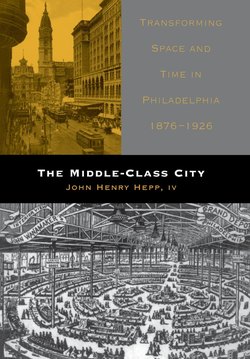Читать книгу The Middle-Class City - John Henry Hepp IV - Страница 6
На сайте Литреса книга снята с продажи.
ОглавлениеPreface
Historians have often viewed the reaction of the American middle class to the sweeping changes wrought by industrialization and urbanization as negative or, at best, ambivalent. The classic interpretation of the late nineteenth and early twentieth centuries sees this period as a political “search for order” by the bourgeoisie. My book examines transformations in everyday middle-class life in Philadelphia between 1876 and 1926 to discover the cultural roots of this search for order. By looking at the complex relationships among members of that city’s bourgeoisie and three largely middle-class commercial institutions (newspapers, department stores, and railroads), it finds that the bourgeoisie consistently reordered its world along new, rational lines during the late nineteenth century. At first, these changes were largely internal to the middle class, only affecting institutions that it used and controlled. Later, during the early twentieth century in particular, the bourgeoisie began to expand this new cultural sense of order to encompass politics as well.
In Philadelphia, these changes in middle-class world view were less inspired by a fear of the future than by a faith in continued progress. Although this confidence was not always unbounded and was occasionally tinged with a sense of nostalgia, the city’s bourgeois men and women saw the region’s transformation as positive. They believed, by and large, that the Philadelphia of tomorrow would be better than that of their day, which in turn was an improvement on the city of twenty years before. This is not surprising, as they were, for the most part, beneficiaries of these changes. Not only could they see tangible economic, scientific, and technological advancement with, at least for many of them, few costs, but their class was largely a product of this new order.
Writing is a highly collaborative process. In the course of this work’s long gestation period, I ran up a lot of debts: emotional, financial, and intellectual. Now is the time to repay some of them, however inadequate these words may be.
First and foremost, special thanks are due my family: my grandparents (the people who first introduced me to late nineteenth- and early twentieth-century Philadelphia), my parents, my long-suffering wife, Julie, and most recently my son John (who has developed at quite a young age a love for department stores, newspapers, and trains). Without them and their interests in history, this project would have never happened.
Next, special credit is owed to my friends and colleagues at the University of North Carolina at Chapel Hill. Peter Filene, William Barney, Peter Coclanis, Jacquelyn Hall, and John Kasson were all supportive, challenging, and engaged throughout the entire process. In addition, many others suffered through parts of the work and helped me think more clearly about key concepts: Stacey Braukman, Gavin Campbell, Sean Doig, Natalie Fousekis, Gary Frost, Kelly Hughes, Kathy Newfont, Steven Niven, Mike Ross, Robert Tinkler, and Michael Trotti.
A large number of archivists and librarians at a variety of institutions helped me throughout my research. There are too many to list but a few went well beyond the call of duty. Linda Stanley, formerly of the Historical Society of Pennsylvania, helped me negotiate that archive’s rich collections and regularly pointed out items that I may have otherwise missed. Virtually the entire staff of the Free Library of Philadelphia’s Print and Picture Collection went out of their way to give me incredible access to their holdings. Finally, special thanks are due to Douglas B. Rauschenberger (of the Haddonfield Public Library) and Katherine Mansfield Tassini (of the Historical Society of Haddonfield), who made special arrangements for me to have greater access to the Historical Society’s collections.
More recently, the faculty at Wilkes University have been very supportive of my writing. My colleagues in History—Joel Berlatsky, Harold Cox, Dennis Hupchick, Jack Meyers, and Jim Rodechko—and English—Darin Fields and Jennifer Nesbitt—have helped me negotiate the often tortuous path of teaching four courses a semester while finishing a book.
In addition to my family, I must thank four organizations for providing funding at key points in the research and writing process. The History Department (through its research grants) and the Graduate School (via its research and writing fellowships) of the University of North Carolina at Chapel Hill provided significant support. The New Jersey Historical Commission gave me a research grant that allowed me to follow a number of leads in New Jersey at a crucial time in my research. Finally, Wilkes University provided a needed grant to help turn my book into a reality.
My final thanks go to my editor at the University of Pennsylvania Press, Robert Lockhart, the readers, and the editorial board for helping in a myriad of ways to shape the final product. It has been a fun adventure and I look forward to doing it again in the future.
